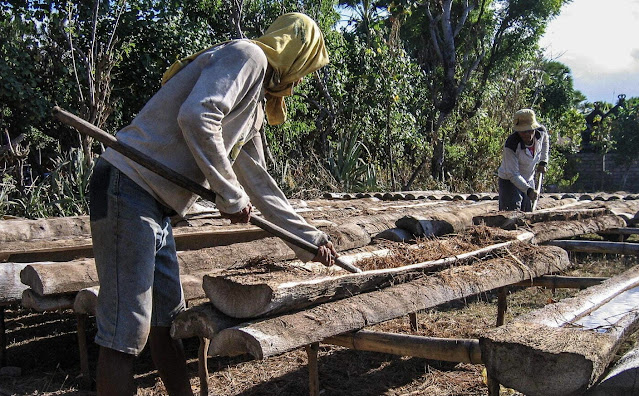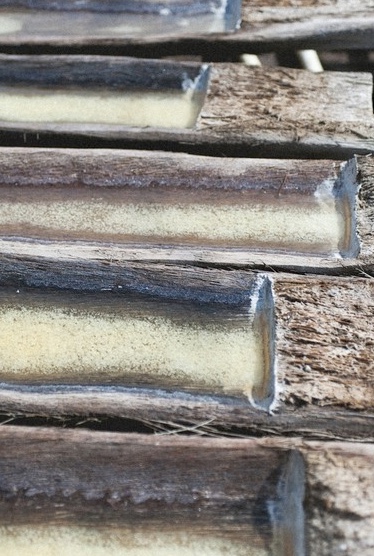 |
| Who knew some of the best flavoured salt existed in Bali |
During our time in Amed, we enjoyed the typical tourist activities like relaxing by resort pools, visiting bars, and dining in restaurants. However, each morning aboard Our Dreamtime, as we sipped our first coffee of the day and watched the sunrise, we noticed men carrying two large buckets back and forth from the sea into the village. This peculiar sight piqued our curiosity. We wondered if they were using it for concrete production or perhaps had an aquaculture farm. Intrigued, we decided to follow one of the men with the buckets to uncover the mystery. What we discovered was truly captivating.
 |
| This is back breaking work |
With a growing emphasis on food preparation, cooks in both household kitchens and the culinary industry are giving significant consideration to a crucial seasoning element. Whether it's table salt, sea salt, or the elaborate Himalayan salt, this essential ingredient, which can either elevate or spoil a dish, is receiving increased attention and recognition.
Indonesia's extensive coastline may seem ironic as it mostly imports salt. However, in recent years, with a growing emphasis on local sourcing and production, salt harvested from the shores of Amed has gained popularity in both home and restaurant kitchens. While I have a variety of salts in Our Galley, I was surprised to discover that the process of making artisian salt is more complex and time-consuming than I had imagined. It takes between 8-10 days to transform seawater into salt and the process is labor-intensive. This newfound knowledge will make me appreciate each sprinkle of salt on my food in the future.
 |
| Removing the excess minerals |
Despite a decrease in the number of traditional sea salt home industries in Bali's Amed area, some farmers have stepped up their production to deliver high-quality salt to their dedicated customers. Nyoman Madiyasa is one of the few remaining Balinese salt farmers, still active in his 70s. He cultivates his salt farm in the northeastern part of the island, using the ancient solar evaporation method. This technique, the oldest in the trade, requires more than just exposing seawater to sunlight. Salt producers must also eliminate metal impurities and retain the salt's natural minerals to ensure quality.
Amed Salt, is renowned for its superior quality and pure natural flavour and has been a staple in the Amed community for centuries. Dating back to 1578 BC, Amed Salt has been the official salt supplier to the Kings of the Karangasem Kingdom. Today, the traditional handcrafted methods of salt production in Amed are valued, safeguarded, and acknowledged as Geographical Indications in Indonesia and Europe. Amed sea salt is on par with the esteemed French Guérande salt, both holding the international Geographical Indication certification, which signifies the excellence, origins and natural processing methods of the product.
 |
| At $84 AUS it must be good right? |
Mardiyasa and fellow salt farmers typically begin their day early to prepare filtered seawater for drying later in the afternoon. Each farmer walks about 7.5km daily, with half of that distance covered while carrying two buckets filled with seawater for salt harvesting.
The sandy soil found in the beaches, known as tanah sari, is where Amed Salt is created. This soil contains clay that naturally absorbs salt minerals from the seawater, eliminating the need for salt makers to construct salting ponds. Instead, the drying and crystallization processes only require drying trays crafted from coconut tree trunks. This method is well-suited for salt production in Amed, an area with limited coastal space but abundant coconut and palm trees. The exceptional quality of Amed Salt is deeply connected to the traditional technique passed down through generations.
In the past, Amed's beaches and other villages were filled with these salt production structures, which have now been replaced by modest boutique resorts. Many local families have moved away from the arduous and low-paying salt-making profession. Today, only a few small communities, particularly in Amed village and Jemeluk, continue to produce salt. On these beaches, you can witness vast open spaces with rows of wooden trays filled with evaporating seawater transforming into salt, alongside peculiar large conical structures, all set against the majestic backdrop of Mt. Agung, Bali's revered mountain.
Established formally in 2015, the Bali Amed Salt producers association, comprises of no more than 20 local salt artisan families who are active members. Within the 20 members, only two farmers have their own fields for cultivation. Mardiyasa mentioned that a decade ago, salt farms in his village extended over 3 kilometers along the coast, but now only 1 km remains. He expressed his hope for the survival of their salt-making tradition and urged against converting the salt farms into hotels. Despite the declining number of families continuing the tradition. A walk along the beach reveals these salt farm outsiders find the sight of rows of wooden trays along the beach quite intriguing. This traditional process is certainly tourism worthy with so much history to tell.
Bali Amed Salt crystals crumbles easily in the mouth and provides a salty taste that is easily lost without excessive bitterness. Some reviews suggested it tastes “umami” and it does not have the bitter after-taste as the more common salt. The Association is working on developing new product ranges with experts and investors and as well as increasing its annual production volume. Currently Bali Amed Salt is available in two types: regular sea salt crumbs and salt flower.
The farmers sell the salt to distributors at Rp 8,000 to 10,000 (0.80 - $1 AUS) per kilogram. Where a 400grm jar of Amed salt will set you back $8.50 AUS in a retail outlet.
 |
| Children sell the salt to tourists as they walk on by |
 |
| The salt farms are along the beach front to the east |
 |
| It is a contuous job of moving the troughs to ensure the sea water is evaporating evenly |
 |
| It's hot work |
 |
| Much cheaper than the French counterpart, but I feel the farmers aren't getting a fair slice of the profit. Let us know you thoughts below in comments. You can purchase your jar of Amed, Bali Salt from East Java & Co Thank you for reading to the end of this blog. Through our Social Media, YouTube, Blog and Books, our goal is to provide valuable insights to help future sailors prepare effectively for their journey. If you are heading into Indonesia you maybe interested in 3 of our other interactive Ebooks we have written. Follow in Our Wake - Indonesia Part 1 an interactive guide for anchorages, tracks, destinations and more. Indonesia Awaits which is a guide to help with the officialdom of entering Indonesia Ready to Set Sail which is a guide to help with the officialdom of leaving Australia These books along with others can be found on Our Book Shelf Please check out our Social Media on Instagram Facebook and of course our fortnightly episodes on YouTube Cheers R&K Thank you to all who support us through watching our videos, reading our blogs or who step up and support us though Patreon and Ko-Fi. You inspire us everyday to be creative 🙌 You can help us out and support our creative work for FREE. By watching, 👍, 🔔, Subscribing, Commenting and best of all Sharing this video or blog with your friends If you would like to make a donation towards our creative work, or become a regular subscriber to Our Virtual Crew you can by heading over to Ko-Fi they take no fees so the support goes directly into helping us buy and upgrade equipment. You get behind the scenes updates, Patreon only photos and posts, you can watch our episodes ad free and before they go public … you get it first! Do you want more? Patreon gives you that … you get behind the scenes updates, Patreon only photos and posts, you can watch our episodes ad free and before they go public … you get it first! |











No comments:
Post a Comment
We love to read your comments regarding our blog, what you enjoyed and what you might like to see more of. Please leave us your thoughts.